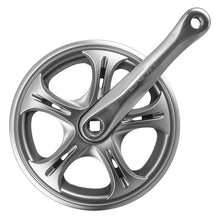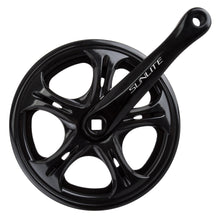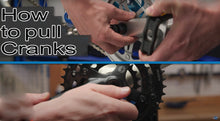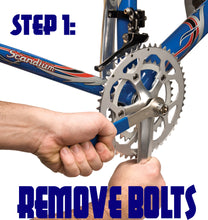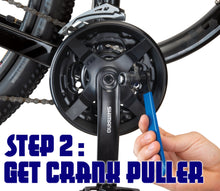
Unveiling the Sunlite Big City Single Speed Crank: A Blend of Strength and Style
In the world of cycling, every component matters, and the Sunlite Big City Single Speed Crank is a standout choice for those seeking durability, efficiency, and a dash of urban style. This article will delve into the key features of this remarkable single-speed crankset and why you should consider making your purchase from a reliable source like Live4Bikes.
Key Features of the Sunlite Big City Single Speed Crank: (for 7/8 Speed bikes)
-
Rugged Construction: The Sunlite Big City Single Speed Crank is engineered for toughness. It boasts a steel chainring coupled with forged alloy crank arms, ensuring it can handle the rigors of city commuting and urban cycling. Whether you're navigating potholes or hopping curbs, this crankset is built to withstand the demands of the cityscape.
-
Double Chainguard: Safety is a top priority for urban cyclists. The Sunlite Big City Crankset features a double chainguard that helps keep your pants or shoelaces clear of the chain, preventing accidents and keeping your clothing clean during your ride.
-
Chain Compatibility: This crankset is designed to work seamlessly with 3/32" chains, which are standard for many single-speed and urban commuter bikes. Its compatibility ensures you can easily find a matching chain for your setup.
-
Chainline: The 45mm chainline ensures efficient power transfer and a smooth pedaling experience. It's an important feature that helps keep your chain in line, reducing the risk of chain drops and ensuring a more consistent ride.
-
Multiple Length and Teeth Options: The Sunlite Big City Single Speed Crankset is available in different length and teeth combinations, such as 170x48. This allows you to select the configuration that suits your riding style and terrain, whether you prefer faster spins or more torque.
-
Spindle Type: The spindle type of this crankset is 118 SQR JIS, which is a common standard for many single-speed and fixed-gear bicycles.
-
Color and Bolt Pattern: It comes in a sleek silver (SIL) color, adding a touch of elegance to your bike's aesthetics. While it does not feature a specific bolt pattern, the compatibility with standard 3/32" chains ensures ease of installation.
-
Speed: The Sunlite Big City Single Speed Crankset is designed for single-speed bikes, making it an ideal choice for urban commuters who prefer the simplicity and reliability of a single gear.
- Steel chainring with forged alloy crank arms and double chainguard
- Compatible with 3/32" chains
- 45mm chainline
| Length / Teeth: | 170x48 | Spindle Type: | 118 SQR JIS |
| Color: | BLK | Bolt Pattern: | N/A |
| Speed: | 1 |
 |

|
 |
 |
- More Crank info
- DIY TIPS
- Minimize Windows
Understanding Bicycle Cranks: Types, Sizes, and Materials
Introduction
Bicycle cranks are a crucial component of a bike's drivetrain, responsible for transferring the rider's pedaling force to the chainring, which in turn propels the bicycle forward. In this article, we'll explore the various types of bicycle cranks, different sizes available, and the materials they are constructed from.
Types of Bicycle Cranks
-
Square Taper Cranks:
Square taper cranks are a traditional design, characterized by a square-shaped spindle that fits into the bottom bracket. They have been a standard for many years, known for their simplicity and durability. However, they are becoming less common with the rise of newer technologies.
-
Octalink Cranks:
Shimano introduced the Octalink system, which features eight splines on the crank arm that interface with a matching bottom bracket. Octalink cranks are known for their increased stiffness and power transfer compared to square taper cranks.
-
ISIS Drive Cranks:
ISIS (International Splined Interface Standard) drive cranks use a splined interface between the crank arm and the bottom bracket spindle. This design was intended to improve stiffness and durability, but it has been largely replaced by newer standards.
-
External Bearing Cranks:
External bearing cranks, also known as Hollowtech II (by Shimano) or GXP (by SRAM), use outboard bearings that sit outside of the bottom bracket shell. This design provides increased stiffness and weight savings.
-
Direct Mount Cranks:
Direct mount cranks have become popular in recent years, especially in the mountain biking community. They attach directly to the spindle, eliminating the need for a separate chainring spider. This design allows for a wider range of chainring sizes and improved stiffness.
Different Sizes of Bicycle Cranks
-
Crank Arm Length:
Crank arm length is measured from the center of the bottom bracket spindle to the center of the pedal spindle. Common lengths range from 165mm to 180mm. Shorter crank arms can provide a more aerodynamic position and are favored by some cyclists, while longer crank arms may offer more leverage for powerful pedaling.
-
Chainring Sizes:
The size of the chainring(s) on the crankset can significantly affect the bike's gearing. Smaller chainrings provide easier pedaling but lower top speeds, while larger chainrings offer higher top speeds but require more effort to pedal.
Materials Used in Bicycle Cranks
-
Aluminum:
Aluminum cranks are lightweight, relatively inexpensive, and offer good stiffness. They are popular in entry-level and mid-range bicycles.
-
Carbon Fiber:
Carbon fiber cranks are known for their exceptional strength-to-weight ratio. They offer excellent stiffness and can help reduce overall weight, making them popular among high-end and performance-oriented cyclists.
-
Steel:
Steel cranks are durable and cost-effective but tend to be heavier than aluminum or carbon fiber options. They are commonly found on budget-friendly and commuter-oriented bikes.
-
Titanium:
Titanium cranks strike a balance between weight, strength, and durability. They are relatively lightweight and offer excellent corrosion resistance, making them a premium choice for some cyclists.
Conclusion
Choosing the right bicycle crank is essential for optimizing your riding experience. Consider factors like the type of riding you'll be doing, your personal preferences, and your budget when selecting a crankset. Understanding the different types, sizes, and materials available will help you make an informed decision that suits your specific cycling needs.
```Comprehensive Guide to Removing a Square Taper Bicycle Crank
Tools Needed:
- Crank puller tool (compatible with square taper cranks)
- Allen wrench or socket wrench set
- Bottom bracket tool (if necessary)
- Grease (optional)
- Rag or cloth (to clean and wipe parts)
Step-by-Step Guide:
-
Prepare Your Workspace:
Start by finding a clean, well-lit area to work. Lay down a rag or cloth to catch any dirt or small parts that may fall.
-
Gather Tools:
Ensure you have all the necessary tools listed above.
-
Prepare the Bike:
If you have a derailleur, shift the chain onto the smallest chainring to provide easier access to the crankset. If you have a single-speed or fixed-gear bike, you don't need to worry about this step.
-
Remove the Crank Bolts:
Use an Allen wrench or socket wrench to loosen and remove the bolts that hold the crank arms onto the bottom bracket spindle. There are usually two bolts, one on each side.
-
Use the Crank Puller:
Insert the inner part of the crank puller tool into the bottom bracket spindle. Make sure it's threaded securely. Then, thread the outer part of the tool into the crank arm threads. Tighten the outer part of the crank puller tool until the crank arm starts to come off the spindle.
-
Remove the Crank Arm:
Continue to turn the crank puller until the crank arm comes off the spindle. Be sure to support the crank arm with your hand as it comes free to avoid it falling and potentially damaging the ground or other components.
-
Repeat for the Other Side:
If you're removing both crank arms, repeat steps 4-6 for the other side.
-
Inspect and Clean:
Take this opportunity to inspect the bottom bracket and crankset for any signs of wear or damage. Clean the spindle and bottom bracket shell if necessary.






